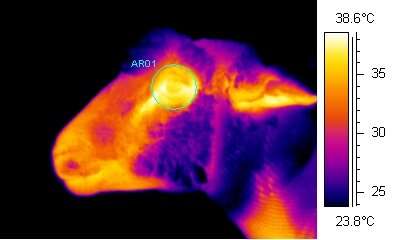Credit: AgResearch
Thermal imaging technology is being used by AgResearch scientists to gain greater insights into how livestock experience stress, and how that knowledge can help enhance animal welfare.
Research in which the technology is focused on sheep has been published today (30 May) in the PLOS ONE scientific journal, entitled Evaluation of infrared thermography as a non-invasive method of measuring the autonomic nervous response in sheep.
"For some years now at AgResearch we've been looking at how infrared thermography (using a thermal imaging device that detects the amount of infrared energy an object radiates) can help us gain a better understanding of the stress levels livestock may be experiencing, and therefore their welfare," says AgResearch senior scientist Dr. Mhairi (pronounced Vaa-ree) Sutherland.
"A key advantage of this technology is that it is non-invasive, when clearly the aim is not to add to the stress of the animal in the course of trying to take these measures. The technology has also been used to detect the presence of disease or inflammation in animals that may require further investigation."
"After demonstrating that infrared thermography could be used to measure stress in cattle, we undertook similar research in ewes (female sheep) where we focused on temperature changes of the eye region as a measure of stress and activation of the autonomic nervous system. By comparing ewes injected with epinephrine (also known as adrenaline) and those without, we were able to see a subtle difference in temperature change as measured from the eye. We focused on the eye region of the sheep given that it is free of wool and can therefore provide an area to measure that is not obstructed, but we did look at other areas of the body such as the ear, where there may also be the potential to detect changes in temperature that relate to stress."
"At this stage, infrared thermography is being used primarily as a research tool in this area, but there is certainly potential for this technology to be integrated into farming systems, where animals may for example be directed to pass by an infrared thermography device checkpoint to take measurements relating to stress or health. Once you have the tools to measure stress levels in animals, you can of course then look at what situations or circumstances are causing more stress for the animals, and how you can adapt farming practices to reduce this and enhance their welfare."
"Our experience is that farmers want the best for their animals and are open to how to evolve their practices, and we know that good welfare standards are also an important factor for consumers of food and fiber produced in New Zealand."
More information: Mhairi A. Sutherland et al. Evaluation of infrared thermography as a non-invasive method of measuring the autonomic nervous response in sheep, PLOS ONE (2020). DOI: 10.1371/journal.pone.0233558
Journal information: PLoS ONE
Provided by AgResearch
























